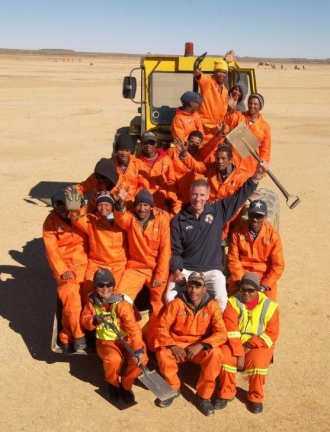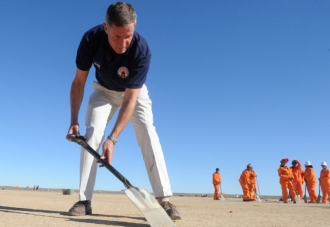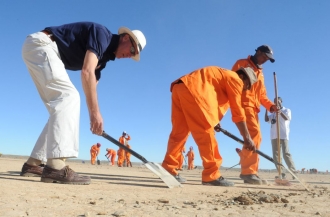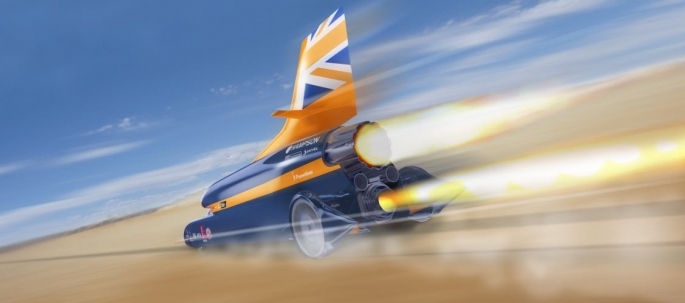
On 24 July 2012, Land Speed Record (LSR) holder Andy Green will be visiting Hakskeenpan in the Northern Cape Province of South Africa to view progress on the world’s fastest race track.
 A team of 300 previously unemployed people funded by the Northern Cape government joined some volunteers to clear 10 million square metres of desert race track. With only two months’ work remaining on the run-off areas, the team has cleared 6,000 tonnes of stones from the 500m wide, 20km long stretch of desert. The clearing project spanning twenty-four months is set to be completed within the next few months in time for the BLOODHOUND SuperSonic Car to begin high speed testing on the pan during the summer of 2013.
A team of 300 previously unemployed people funded by the Northern Cape government joined some volunteers to clear 10 million square metres of desert race track. With only two months’ work remaining on the run-off areas, the team has cleared 6,000 tonnes of stones from the 500m wide, 20km long stretch of desert. The clearing project spanning twenty-four months is set to be completed within the next few months in time for the BLOODHOUND SuperSonic Car to begin high speed testing on the pan during the summer of 2013.
Andy Green, a serving officer with the Royal Air Force, set a new Land Speed Record of 1228 kilometres per hour in October 1997. A small team lead by former LSR holder Richard Noble defied the odds and the scientific convention of the day to break the sound barrier – a feat many thought impossible. This record still stands.
Today, Andy Green, Richard Noble and many of the Thrust SSC team are engaged on a new and far more ambitious project: to build a car capable of achieving 1600 km/h. However, the BLOODHOUND Project is not primarily about speed. Rather, it is an international education initiative aimed at inspiring the next generation of scientists, engineers and mathematicians by demonstrating these subjects in the most exciting way possible. The unique nature of the World Land Speed Record, where the challenge comes from confronting the laws of physics rather than other teams with similar technology, means the BLOODHOUND Project can share all its data, designs, achievements and setbacks in the process.
Consequently, the initiative is already being followed in 217 countries with approximately 7-million learners from 48 countries around the world registered to access BLOODHOUND information and lesson materials in class. The team has made presentations to hundreds of thousands of people since its launch at London’s Science Museum in October 2008.
 picture: courtesy of Emile Hendicks, Foto 24 in South Africa
picture: courtesy of Emile Hendicks, Foto 24 in South Africa
According to Mrs Grizelda Cjikela, Northern Cape MEC for Education, their collaboration with this ground-breaking initiative underpins the province’s commitment to education and scientific innovation. “Education is the key to economic development, not only within the Northern Cape, but also the whole of South Africa. A project such as BLOODHOUND has the potential to inspire a whole generation of learners. As a government collective we are obligated to explore all opportunities to develop the province as a hub for technological and scientific advances. In recent years, this vision has been substantiated by not only being selected as the preferred site for the BLOODHOUND attempt, but also by winning the bid to host the Square Kilometre Array. With the recent announcement that the province’s first university will be established in Kimberley, we are firmly on track to provide our youth with the opportunity to build an incredibly bright future,” stated Cjikela.
The Northern Cape provincial government has actively partnered with initiatives such as BLOODHOUND as it has significant socio-economic benefits for the province. Not only does the strong educational focus deliver in terms of youth development, but BLOODHOUND will also make an economic contribution while simultaneously boosting technological skills. The event will also create massive media exposure internationally, which allows the province to showcase the unique diversity of its tourism offerings. Since repositioning itself as a premier destination for adventure and extreme sports, the Northern Cape has already attracted niche markets such as skateboarding, waterskiing and even motor racing.
Meanwhile, Dave Rowley from the BLOODHOUND education team, is now based full-time in South Africa with the Northern Cape Department of Education developing links with schools, colleges and universities across the country. Already 45 local schools have signed up with the education programme. Numerous partners have been recruited to support this programme, including Scifest Africa, Sci-Bono, Cape Town and Sci-Enza science centre, the South African Institute of Mechanical Engineering, ECSA, the British High Commission and the British Council. Many education suppliers have committed to support the programme, including Edit Microsystems who will be supplying free resources to schools, NEC and the Sangari Institute, who have recently launched the BLOODHOUND Class as part of F1 in schools. The Ambassador programme has also been launched and 15 engineers, scientists and speed enthusiasts have been recruited to help promote and deliver the education programme to schools across South Africa.
 picture: courtesy of Emile Hendicks, Foto 24 in South Africa
picture: courtesy of Emile Hendicks, Foto 24 in South Africa
Andy Green said “I’m standing in the middle of the Hakskeenpan on a perfectly cloudless winter's day and looking 10 km in each direction I’m standing in the middle of what is rapidly becoming the worlds best race track. The team of 300 South African workers have now finished clearing the main track 500 m wide and are now preparing the safety areas. They have already cleared 10 million square metres by hand and left the most perfect surface to run on. They are all enormously excited about the car coming to the Northern Cape next year, and having seen the work they’ve done I’m equally excited about getting it out here and starting to run at some very high speeds.” He continued, “We are enormously grateful for the fantastic support from the Northern Cape, because without their help we couldn’t have done this.”
BLOODHOUND SSC is the result of remarkable engineering that allows the ultimate racing car to accelerate from 0 – 1609 km/h and back to zero in just 120 seconds, while sagely handling the phenomenal forces and loads acting upon it such as 47000 pounds thrust (equivalent to 180 F1 cars) generated by its jet and rocket engines; 30 tonne suspension loadings; air pressures on the bodywork of up to 10 tonne per square metre and solid aluminium wheels, each weighing 105 kg spinning at 10,200 rpm and generating an extraordinary 50000 G at the rim.
Currently well into the building phase of the project, large sections of the car are in manufacture. UMECO will shortly begin the lay-up of the carbon fibre monocell (cockpit) and the fabrication of the steel and aluminium rear chassis has begun at Hampson Aerospace in the United Kingdom. The BLOODHOUND engineers will have a rolling chassis assembled by the end of the year and aim to start UK runway testing up to 321 km/h in summer 2013. The team will then decamp to Hakskeenpan in South Africa to start the high speed shake down runs.
ENDS
For media enquiries, please contact
UK Jules Tipler - [email protected] / +44 7811 166 796
SA Ronelda Visser - 0832733984
Animations can be viewed online at www.youtube.com/1050mph - also available in broadcast quality.
NOTE TO EDITORS:
Why Hakskeenpan:
It may be the world’s most powerful land vehicle, but BLOODHOUND SSC needs a very special track to run on if it is ever to break records.
As soon as the project was launched, the search for a run site began. With the car designed specifically for the one environment in which it would run, getting the right location was critical. Clearly BLOODHOUND needed a wide, open area of very flat land. Given that the car runs on solid wheels as no tyres are able to withstand the colossal rotational forces, the ground surface was just as important; the priority was to find a dry lake bed, which would afford a slight agree of ‘give’ and thereby cushion the car’s ride.
Swansea University created a bespoke computer programme to scour satellite earth observation imagery and assessed over 20 000 potential sites. Green then flew across the world to check favoured locations in person and conducted details on-the-ground investigations.
After two years and several ‘near misses’, the perfect run site was identified: Hakskeenpan in the Northern Cape. Supported by the Northern Cape government, the local community with some volunteers have almost completed the Herculean task of preparing the area ahead of its first high speed runs in 2013.
Driving at 1600 kilometres per hour:
Building and driving a rocket and jet powered supersonic car is an inherently high-risk undertaking. BLOODHOUND SSC is an experimental prototype challenging the laws of physics in order to travel one mile (1.6 km) in just 3.6 seconds, significantly faster than a bullet from a .357 Magnum. The only way to mitigate risk is to use absolute best practise and build-in safety at every stage: from tuning the aerodynamics so that they keep the car on the ground and stable throughout its speed range, through to the safe handling of the various chemicals needed to refuel BLOODHOUND during a record attempt.
The specification of the rocket, and the choice to use both jet and rocket power in the car, were both informed by the desire for safety.
Driver Andy Green will initially use the power of BLOODHOUND’s EJ200 Eurofighter engine alone to build up to 350 mph – the jet’s controllability making it easy for him to shut down in the event of a problem at relatively low speeds.
Beyond 350 mph, the Falcon hybrid rocket comes on stream, adding its might to the 22,000lbs of thrust produced by the jet. The combined 47,000lbs of thrust, approximating to 133,000 thp, will blast the car to 1689 kph (1,050 mph) in just 52 seconds.
The term ‘hybrid’ stems from the fact that BLOODHOUND’s rocket combines solid fuel with a liquid oxidiser, High Test Peroxide (HTP), to create its power. A staple of UK rocket tests for over forty years, HTP has an excellent safety record. A state of the art, 750 bhp Cosworth F1 engine will be used to pump 963 litres of HTP into the rocket during its 20 seconds burn – a flow-rate of 42.6 litres (75 pints) per second.
If the flow of HTP is throttled back, the rocket will stop burning, giving the driver a level of control which would not be possible with a conventional solid fuel rocket, the kind used to boost the Space Shuttle into space.



